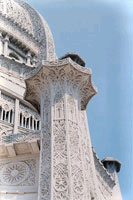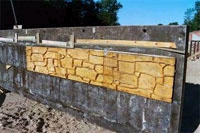 Concrete can take almost any form, texture, and color to enhance the appearance of a building and its functional structural requirements. It offers surfaces that range from smooth to rough and a spectrum of color that ranges from the icy blue of quartz through the delicate pastels to the deep reds of decorative aggregates.
Concrete can take almost any form, texture, and color to enhance the appearance of a building and its functional structural requirements. It offers surfaces that range from smooth to rough and a spectrum of color that ranges from the icy blue of quartz through the delicate pastels to the deep reds of decorative aggregates.
Architectural concrete refers to concrete that while providing an aesthetic finish to the building also serves a structural function.
Decorative concrete typically refers to concrete flatwork or building elements such as panels, that while enhanced with texture or color, are not structural building members.
White portland cement is made of select materials that contain negligible amounts of iron and manganese oxides—the materials that give cement a gray color. Every cement, whether white or gray, has different inherent color tones as a result of slight differences in raw material ingredients and manufacturing processes. Architects should take this into consideration in the design process. When uniform color is critical, it is suggested to stockpile an adequate quantity of cement and aggregate so that consistent color results can be obtained.
 Integrally colored concrete is made by adding mineral oxide pigments to concretes made with either white or gray cements. White cement is used when lighter shades of concrete are desired, but red, tan, and dark gray hues can be produced using gray cement.
Integrally colored concrete is made by adding mineral oxide pigments to concretes made with either white or gray cements. White cement is used when lighter shades of concrete are desired, but red, tan, and dark gray hues can be produced using gray cement.
An exposed aggregate surface is a decorative surface obtained by removing the outer layer of mortar and exposing the aggregate particles. This may be done with a variety of techniques, including chemical surface retarders, sandblasting, water blasting, or acid etching. Selection of aggregates is based on color, hardness, size, shape, gradation, durability, availability, method, and degree of exposure and cost. Popular decorative aggregates are natural materials such as quartz, granite, marble, limestone, and gravel, and manufactured materials such as alkali-resistant glass and ceramics.
 Forms and form liners can be used to create textures and patterns that simulate, for example, brick, stone, and wood. Aluminum wall forming systems are available with brick-pattern faces, or with vertical rib or board-and-batten patterns. Also, a textured concrete surface will help camouflage the subtle differences in texture and color found on the surface of concrete.
Forms and form liners can be used to create textures and patterns that simulate, for example, brick, stone, and wood. Aluminum wall forming systems are available with brick-pattern faces, or with vertical rib or board-and-batten patterns. Also, a textured concrete surface will help camouflage the subtle differences in texture and color found on the surface of concrete.
Read more on
architectural and decorative concrete.